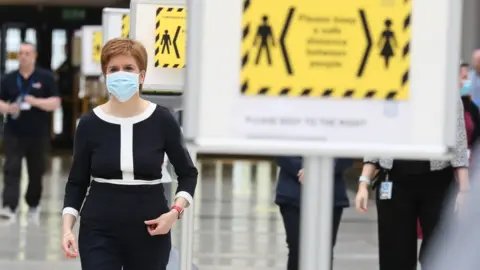Coronavirus: NHS Louisa Jordan used to help clear healthcare backlog
 PA Media
PA MediaPeople who had health care postponed due to the coronavirus pandemic can now be treated at the temporary hospital initially built for patients with virus symptoms.
The £38m NHS Louisa Jordan was built at the SEC in Glasgow in April but has not been needed during the outbreak.
First Minister Nicola Sturgeon said the hospital remained a "vital asset" in resuming NHS services safely.
The hospital has been open to some outpatients in July as part of a pilot.
That scheme has now been judged successful - after 315 people received orthopaedic and plastic surgery consultations since the start of the month.
Following the three-week project by NHS Lanarkshire, the Scottish government said plans were now in place to expand the services offered, and increase the number of patients the hospital can receive daily from health boards across Scotland.
'Need to be flexible'
New services to be offered include X-rays, CT scanning and ultrasounds, as well as speciality dermatology appointments.
NHS Scotland faces a backlog of treatments, after many were paused at the beginning of the coronavirus crisis in a bid to ensure there was enough NHS capacity to deal with a surge of Covid-19-related patients.
Ms Sturgeon said she had always hoped the NHS Louisa Jordan would not be needed for the initial coronavirus response, but the health service now needs to be "flexible and adapt to the new normal."
Speaking on a tour of the hospital, she added: "Although the NHS Louisa Jordan has not been required to treat Covid-19 patients, it remains a vital asset in our phased approach to resuming NHS services safely where we can.
"It is providing capacity to reduce waiting lists and improve outcomes for patients across Scotland."
The first minister said that the hospital is ready to treat coronavirus patients at "just a few days' notice", should there be another spike in infections.
The Louisa Jordan was built in less than two weeks to offer extra capacity to the NHS in dealing with the predicted influx of patients with coronavirus symptoms.
A total of 1,036 bed bays were built and it was initially able to treat 300 patients.
It was named after a Glasgow-born nurse who died in Serbia in 1915 during World War One while working in a hospital.

- SYMPTOMS: What are they and how to guard against them?
- 40,000 DEATHS: Could they have been prevented?
- FACE MASKS: When should you wear one?
- TESTING: Who can get a test and how?

